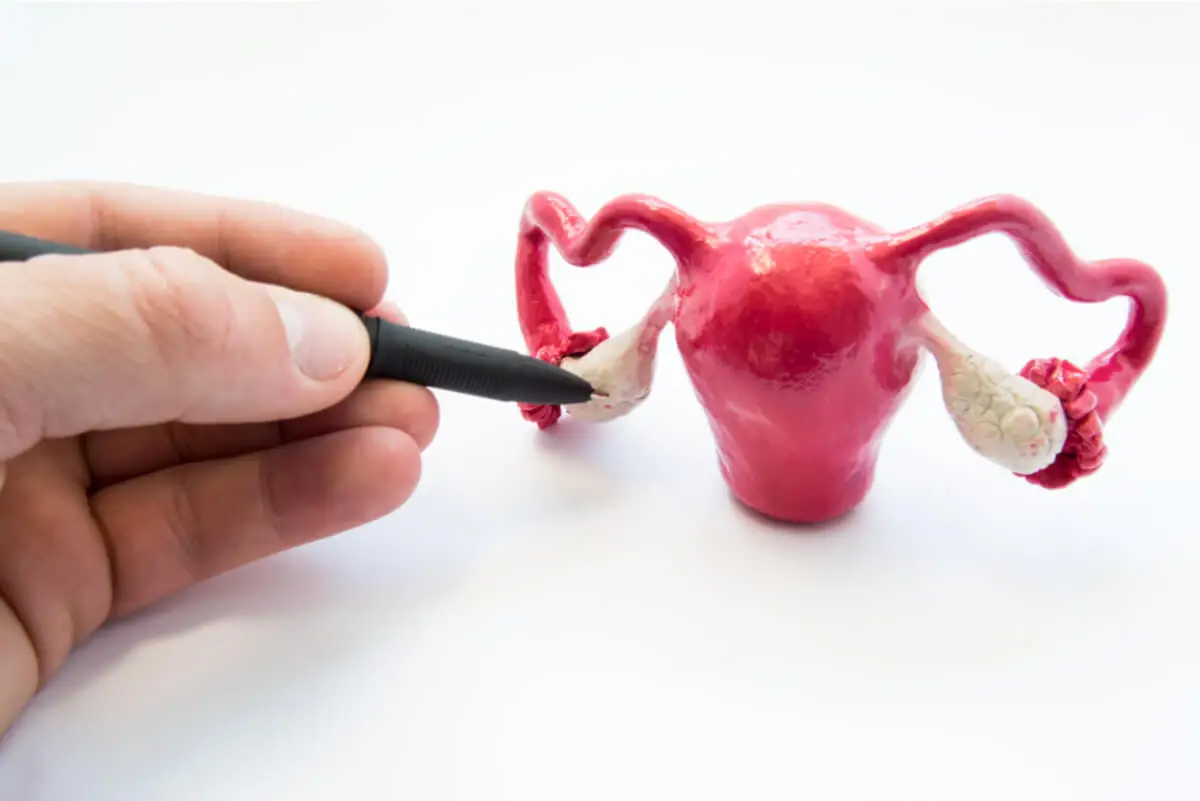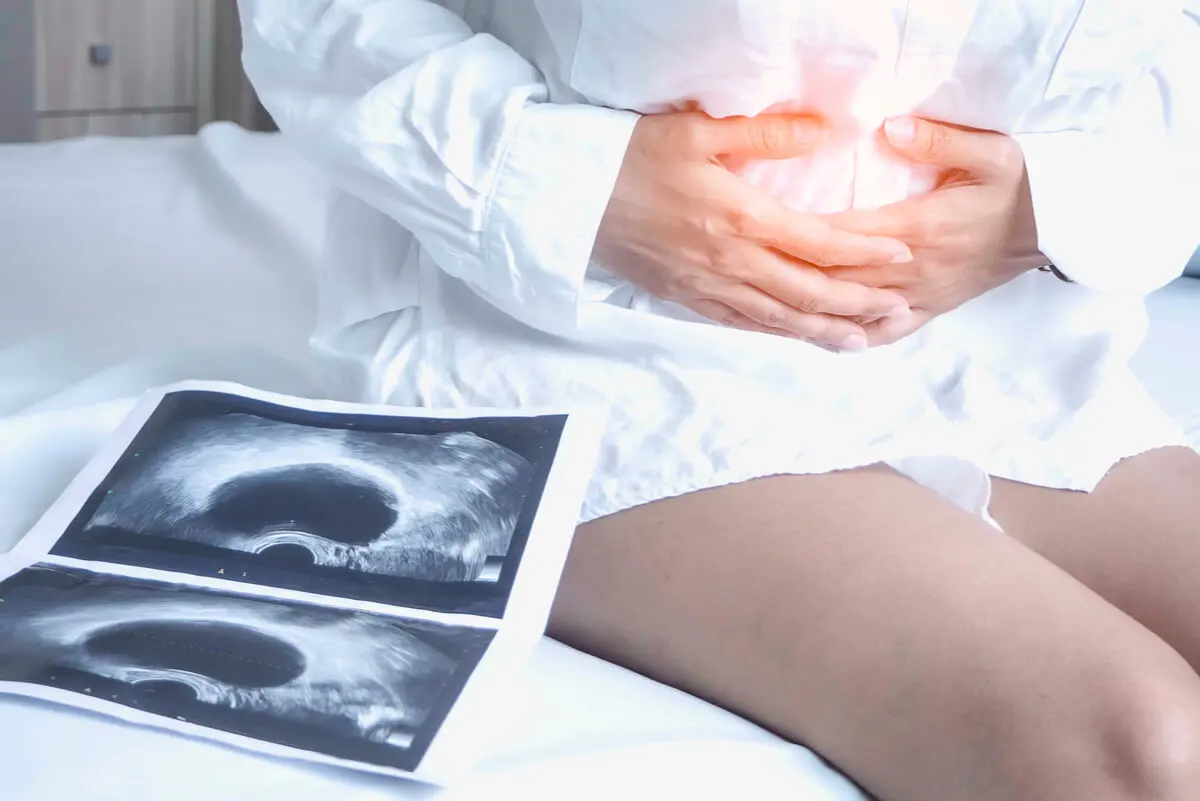Everything You Need to Know About Treatment for Ovarian Cysts


Written and verified by the doctor Elisa Martin Cano
The treatment of ovarian cysts is part of the therapy for benign conditions of the female reproductive system. This lesion is a kind of sac filled with fluid inside the organ or on its surface.
Most women have them at some point in their lives. In fact, it’s a very frequent situation that has a prevalence of around 14% in postmenopausal women alone.
The truth is that these tumors can disappear on their own, without any discomfort. However, in some cases, they cause serious symptoms, which is why treatment for ovarian cysts is necessary. We’ll explain everything you need to know about it in today’s article.
What types of ovarian cysts are there?
As we’ve just pointed out, ovarian cysts are benign growths that appear in this organ. They tend to contain liquid inside. Generally speaking, they can be divided into two categories: functional and non-functional cysts.
Functional cysts are those that arise from an ovarian follicle. Follicles are responsible for releasing the egg in each cycle, as well as being hormone producers. When a follicle doesn’t release the egg and continues to grow, it can end up forming a cyst.
Most of them are self-limiting and disappear on their own after three or four menstrual cycles. In addition, they don’t usually cause pain or any other symptoms.
On the other hand, there are ovarian cysts that are not related to the menstrual cycle, which fall into the category of non-functional cysts. These include cystadenomas, endometriomas, and dermoids, among others. These are associated with an increased risk of complications and therefore require treatment.

We think you may be interested in reading this, too: 7 Reasons You Might Feel Pain in Your Ovaries
What are the complications of ovarian cysts?
Possible treatments for ovarian cysts are focused on avoiding complications that can put the woman’s life at risk. For example, rupture of the lesion could occur with the passage of fluid into the abdominal cavity.
This results in internal bleeding and severe pain in the lower abdomen. The risk of rupture varies according to the size of the lump and is greater in those with a large diameter.
Cysts also cause ovarian torsion. This complication usually manifests with nausea, vomiting, and pain. In addition, the blood flow of the ovary can be compromised, as if strangulation occurred, leading to the death of the cells that compose it.
What is the treatment for ovarian cysts?
In many women, ovarian cysts are detected accidentally during a gynecological examination. The vast majority don’t produce symptoms, so the best way to keep an eye out for them is through regular exams.
Most of them are harmless and go away on their own. That said, when these tumors don’t cause any damage, it’s best to perform a periodic follow-up of the cyst. In this way, the doctor can analyze if it has changed in size or if new symptoms have appeared. On the other hand, when there are risks of complications or symptomatology, there are other treatment alternatives.
Medical treatment for ovarian cysts
Hormonal contraceptives are sometimes recommended to treat ovarian cysts or to prevent them from reappearing. What they achieve is to inhibit ovulation so that new ones do not form. However, they don’t reduce the size of existing ones.
In addition, hormonal contraceptives, such as pills, have numerous side effects. A study published in the Revista Chilena de Obstetricia y Ginecología concluded that there’s no substantial difference between treatment with oral contraceptives and treatment without, so make sure to consider this option carefully if your doctor suggests it.
Surgical treatment
When ovarian cysts are large or growing rapidly, most doctors decide to remove them by surgery. It may even be an occult cancerous process, so removing a cyst is sometimes one of the best options.
Removal is done by two techniques: a laparoscopy or a laparotomy. Furthermore, depending on the nature of the cyst, it’s possible that only this part is removed or that it’s necessary to remove the entire ovary. In the case of cancer, it may even be indicated to remove the uterus and fallopian tubes, as well.
A laparoscopy is usually performed when the cyst is small. It’s done through a minimal incision in the abdomen through which the necessary material is introduced to remove the tumor. Scientific studies affirm that during pregnancy, for example, this is the best alternative.
A laparotomy is reserved for larger cysts. This is a technique that’s done through a large incision in the abdomen. By means of this surgery, the rest of the organs can also be removed, in case of a cancerous process.

We think you may also enjoy reading this article: What Should You Know Before Deciding to Remove Your Ovaries?
What to remember about the treatment of ovarian cysts
Ovarian cysts are a very frequent condition. Most of them are harmless and disappear on their own. However, in case they produce symptoms or there’s a risk of complications, it’s indicated to treat them. That’s why it’s important to consult a gynecologist in the event of lower abdominal pain or any alterations in menstrual bleeding.
The treatment should always be chosen by a specialist. Among the options are contraceptives, with little scientific evidence, and surgical techniques which, in general, offer a better result.
All cited sources were thoroughly reviewed by our team to ensure their quality, reliability, currency, and validity. The bibliography of this article was considered reliable and of academic or scientific accuracy.
- Troncoso J, J. L., Ricci A, P., Albornoz V, J., & Mackenna I, A. (2009). MANEJO LAPAROSCÓPICO DE QUISTES OVÁRICOS COMPLICADOS O PERSISTENTES DURANTE EL EMBARAZO. Revista Chilena de Obstetricia y Ginecología, 74(5), 292–298. https://doi.org/10.4067/S0717-75262009000500005
- Revisión sistemática de la literatura de punción-esclerosis de quistes y endornetriornas ováricos – Dialnet. (n.d.). Retrieved July 24, 2020, from https://dialnet.unirioja.es/servlet/articulo?codigo=3851788
- Trastornos ováricos benignos – Dialnet. (n.d.). Retrieved July 24, 2020, from https://dialnet.unirioja.es/servlet/articulo?codigo=3053509
- Briones-Landa, Carlos Humberto, et al. “Comparación del tratamiento laparoscópico vs laparotomía en teratomas ováricos.” Ginecol Obstet Mex 78.10 (2010): 527-532.
- Hakoun, Abdullah M., et al. “Adnexal masses in pregnancy: An updated review.” Avicenna Journal of Medicine 7.4 (2017): 153.
- Monar Castillo, William Germán. Quiste ovárico en mujeres postmenopaúsicas. BS thesis. Universidad Técnica de Ambato-Facultad de Ciencias de la Salud-Carrera de Medicina, 2015.
- González V, M., Goity F, C., & Kahn Ch, M. (2007). ¿SON ÚTILES LOS ANTICONCEPTIVOS ORALES EN EL TRATAMIENTO DE LOS QUISTES OVÁRICOS FUNCIONALES? Revista Chilena de Obstetricia y Ginecología, 72(6), 402–406. https://doi.org/10.4067/S0717-75262007000600008
- Agostinho, Lisa, et al. “Benign ovarian lesions with restricted diffusion.” Radiologia brasileira 52.2 (2019): 106-111.
- Sánchez, Álvarez, and Aida de la Caridad. “Torsión de ovario.” Revista Cubana de Obstetricia y Ginecología 37.1 (2011): 117-124.
- Fuentealba T, I. (2006). QUISTES OVARICOS EN RECIEN NACIDAS, NIÑAS Y ADOLESCENTES: ASPECTOS ULTRASONOGRAFICOS. Revista Chilena de Radiología, 12(1), 15–20. https://doi.org/10.4067/S0717-93082006000100006
- Le Frère-Belda, M-A. “Clasificación histopatológica de los tumores ováricos.” EMC-Ginecología-Obstetricia 50.3 (2014): 1-24.
This text is provided for informational purposes only and does not replace consultation with a professional. If in doubt, consult your specialist.








